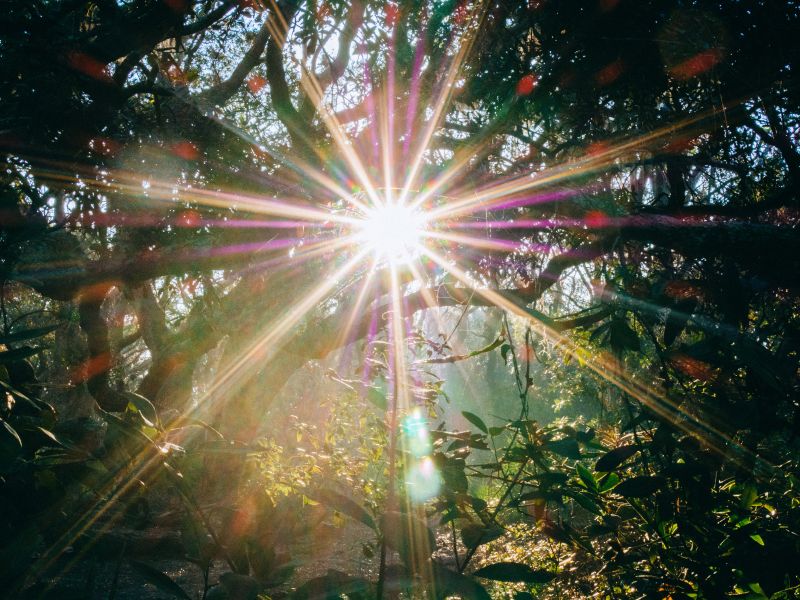
The Mad Agriculture Journal
How the Moon Created the Day
Published on
November 12, 2021
Written by
Calla Rose Ostrander
Photo by
Jane Cavagnero
Last night, my sister and I watched the full Harvest Moon rise over the mountains on the western slope of the Rockies. I stood and stared, and concentrating, I asked my mind to see the Moon not as a disk but as the sphere it is, circling the Earth. My mind did as requested and my vision shifted…
Two-dimensional space giving way to three
and the Moon,
giant, majestic, round being that it is,
became clear to me in the depth of space.
Held close by gravity, it circled between me and the Universe. Its cool reflection fell upon my face as I stood on the Earth, which was itself, in that very moment, circling the Sun.
This morning I walked up the hill behind my house, crisp clay crunching underfoot. Passing under the bows of a juniper tree, I turned and looked at the Sun. For a brief moment, I saw the Sun as I had seen the Moon, a sphere! A great big fiery sphere, vibrating in the sky as it gives us warmth, energy and life. I thought of the story of Coyote stealing fire from the gods to bring to the people on Earth. But that is not the story I want to tell today. On this day, when the Earth is tilted on its axis just so that our days and nights are equal length, I want to tell you a story about how the day as we know it came to be, and how one scientist solved a very big mystery.
Let me start by sharing what this particular mystery was. Many of you may know that a long time ago, certain dark blue bacteria in the vast and shallow seas of our early Earth learned that special trick of making sugar and oxygen out of carbon dioxide and water with the help of sunlight. What you may not know is that it took another billion years before Earth’s atmosphere filled with oxygen. The first Great Oxygenation Event took place about 2.4 billion years ago, while the evolution of photosynthesis in those cyanobacteria took place about 3.5 billion years ago. So there’s a gap. A big gap of 1.1 billion years. We don’t really learn about this gap in school, and if we do, we don’t tend to remember it, but scientists remember it, and it’s been a puzzle up until recently when a woman named Judith Klatt from the Max Planck Institute, had a brilliant insight.
Before we get to what her insight was, we need to come back to today…
This day of equal light,
and equal dark,
equal dawn,
and equal dusk.
We need to come back to this 24hr day,
because this day
as we know it,
did not always exist.
Back when those cyanobacteria were first learning photosynthesis and the atmosphere was still made up of just nitrogen and carbon dioxide, the planet lacked the oxygen which makes life as we know it possible. Back then, the Earth was spinning much faster around its tilted axis, the day was short.
Very short.
Six hours short, in fact.
Now, remember that plants breathe out oxygen in the day- when they are working with sunlight, and they breathe it in at night when it is dark. In those days, when the equinox produced just three hours of light and three hours of night, those little blue bacteria, even though they had formed long and wide mats that stretched across the seas, did not have enough time to build up an excess of oxygen. They essentially breathed in what they breathed out. Judith realized this when she was working with cyanobacteria that she harvested from shadowy pools, deep in Lake Huron which receive very little light, and took them back to her lab where, under more light, they began to breathe out greater quantities of the life-giving gas.
This brings us back to the puzzle of what happened 2.4 billion years ago and Judith’s insight. Can you guess what it was?
What pulls water from the roots of all plants
up into their leaves?
What drives tides
in our oceans
and influences the cycles of fertility
in human females?
The Moon, just about 2.4 billion years ago, through a series of geological events, moved farther away from the Earth. As it did, its gravitational pull on the Earth lessened, slowing the speed of our axial rotation and lengthening the day to 21hrs. Then, just about 700 million years ago in another galactic skip of sorts, the Moon moved away again, further slowing the Earth’s rotation to 24 hours. This move also corresponds with another increase in Earth’s atmospheric oxygen levels. Judith checked the records, and just to be sure, she built a big model to test the theory. Her article came out a few months ago in the prestigious journal Nature Geoscience.
But, wait come back with me and
just for a moment,
let’s forget the complexity of the science.
Let’s go back to the reverence
of watching the full Moon rise.
Of seeing the Sun
alive
in the sky
on this day of equality
between night
and light.
And let us give thanks
to the Moon
for helping to make
the day.
Klatt JM et al. (2021) Possible link between Earth’s rotation rate and oxygenation. Nat. Geosci. 14, 564–570 https://www. nature.com/articles/s41561-021-00784-3